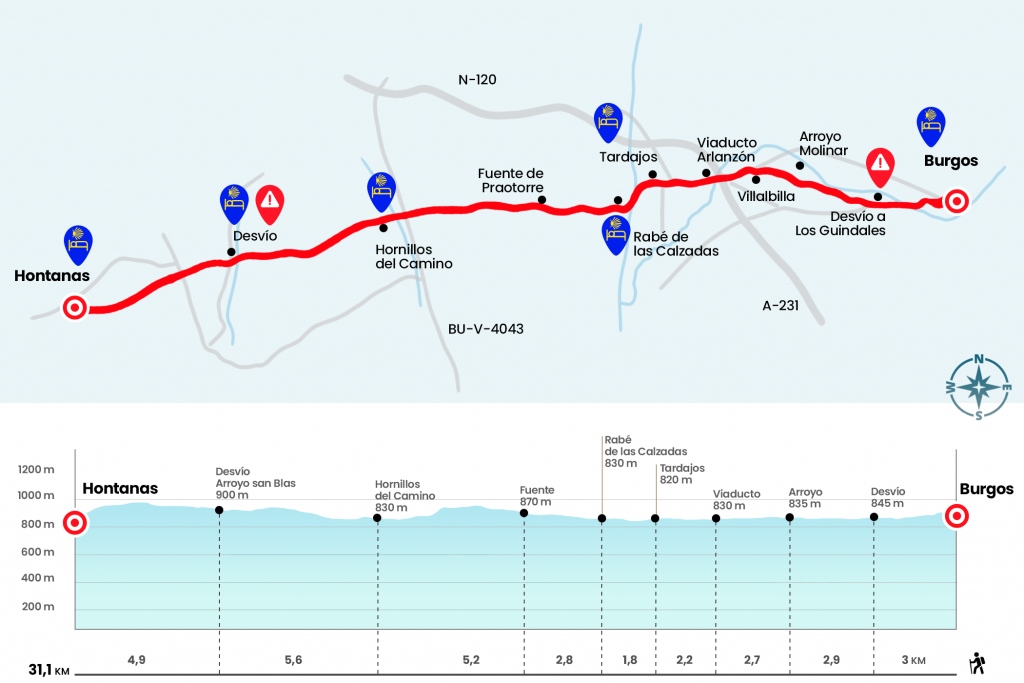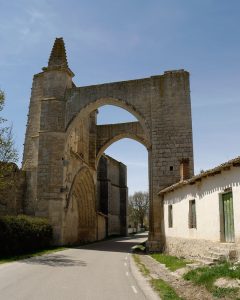Article translated by an automatic translation system. Press here for further information.
Burgos to Hontanas Stage
We leave Burgos and cross the Castilian plateau
Information about the stage 13: Burgos to Hontanas Stage

Enlarge map
Points of interest in the stage 13: Burgos to Hontanas Stage
The route
- Km 0. Burgos (All Services)
The last steps through the Burgese capital are born behind the cathedral, on Fernán González Street. We advance to the arch or door of San Martin, of horseshoe in Mudéjar style and very restored in the 20th century. After the bow, we turn left to descend down stairs to Emperor Street. A little later we continued, on the left, on Villalón Street, which leads to the Island Walk, at the foot of the river. We cross the Arlanzon and turn right along its margin. Always
facing, at the foot of the N-120 by the avenues of Palencia, José María Villacián Rebollo -next to the park el Parral- and the street of Villadiego, we will reach the detour marked as “Los Guindales. Nursery Forestal” (Km 3).
We took it, we turned to the right, and we kept on facing Benito Pérez Galdós Street. Next to the forest nursery door the city ends and the asphalt becomes ramp. The road does not enter Villalbilla, a town that we see on our left, we pass under the line of the AVE and turn left to save the N-120 in underground steps and shortly thereafter the BU-30 motorway, once we pass under the latter we turn right to a roundabout where we take a parallel track to the N-120, cross the Archbishop's River through the Archway.
- Km 10.8. Tardajos (Hostel. Pension. Bar. Store. Pharmacy. ATM)
In Rome, Tardajos was, or could be, a mansio of the Roman road that united Clunia (the Burgese Coruña del Conde) with Juliobriga (the current Reinosa). We overtake the town by Calle del Noon, Plaza Leandro Mayoral and Calle Real Poniente. We headed by road to nearby Rabé. In the short drive we pass the Urbel River. This channel, which runs over 50 kilometres through the province of Burgos, has little flow but is very friendly to overflow and encharade susriberas.
So long as Tardajos and Rabé were separated by a section of mud that gave rise to singing: "From Rabé to Tardajos you won't be missing jobs. From Tardajos to Rabé, Liberans Domine." Melodic stanza that we can sing until we reach Rabé de las Calzada.
- Km 12.6. Rabé de las Calzada (Hostels. Bar)
On Santa Marina Street we went over the fountain - decorated with veneras - to Plaza Francisco Riberas and we went out through Baldomero Pampliega. What awaits us from now on is simply the Castilian plateau. No trap or cardboard, with its pros and cons. Long straight at more than eight hundred meters high with no more companionship than our own shadow and large extensions of cereal with no apparent horizon but with a multitude, yes, of partridges, larcends, cuttings and other birds wanting to grow. Skipping the plateau means breaking the unity of the Camino and subtracting its meaning. Almost three kilometers from Rabé, on the right hand, is the fountain of Praotorre, where tables for rest have been set (Km 15,4).
The runway continues with its bearable climb to reach a flatter area that gives access to the valley where Hornillos sits (Km 17.9). The slope, the inertia itself and the weight of the backpack force the stony costs to be
taken care of, called Matamulos. After crossing a road and the riverbed Hormazuela we enter Hornillos del Camino, population aged to the Camino with a main road from east to west.
- Km 20.6. Hornillos del Camino (Hostels. Bar. Store)
In the summer of 1990, on its own initiative, Lourdes Lluch (which continues to host pilgrims during the winter in its hostel in Frómista) rented here
a house to welcome the pilgrims, an experience that established the function of the volunteer hospital who, year after year, since then, collaborate selflessly in the donor hostels.
At the exit of Hornillos, the panorama is similar to the previous one: an endless plot path that ascends through the cerealist plateau. The only distraction
is at the edges of the road, decorated by piles of stone taken by farmers from their crops. Five kilometers after Hornillos we found a cross of Santiago (Km 25.5) and seven hundred meters later with the crossing towards the San Bol hostel, located near the river of the same name.
- Km 26.2. Arroyo San Bol (Hostel)
After one more hour of walking we finally arrived at Hontanas, clutched and hidden until the last moment. The name of the population comes from the Latin term fontana, a source in Spanish. The Boloñese priest and assiduous pilgrim (traveled to Compostela three times in the years 1666 and 1673), Domenico Laffi, reported that in Hontanas the shepherds surrounded their cottages with a wall to defend themselves from the wolves. Today, several hostels, hostel and rural house offer comfort and rest to the 21st century walker.
- Km 31.1. Hontanas (Hostels. Hostel. Casas Rurales. Bar. Store in season)
The difficulties
Remarks
In images
What to see, what to do
The hostels

¿Do you want to send any photo of "The Camino de Santiago"?
If you have any photos of "El Camino de Santiago" that you want to share with us, you can send them to us and enlarge the photo gallery


Forum: What pilgrims think about the Camino de Santiago
See all